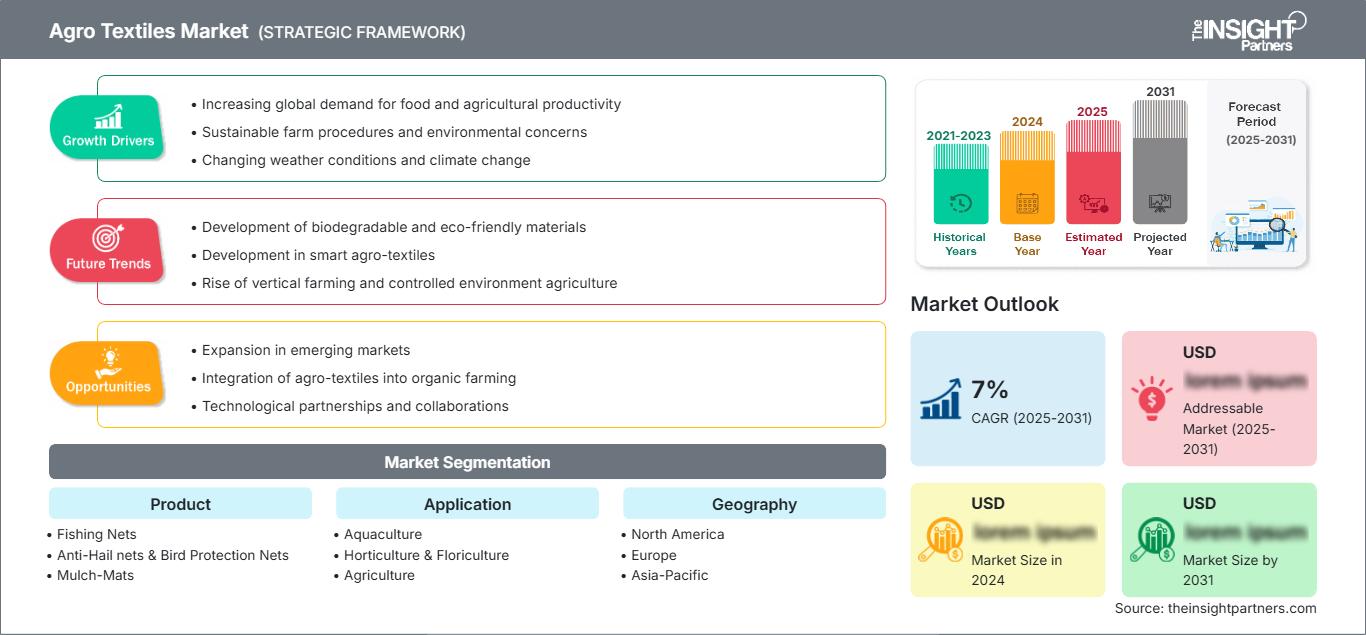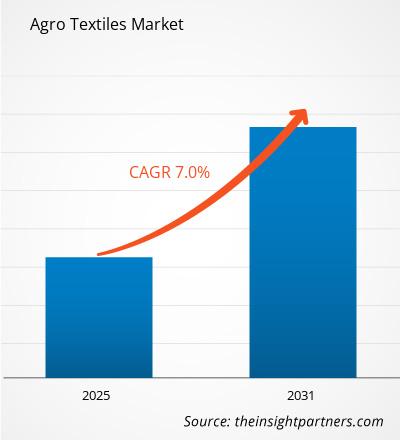Der Markt für Agrartextilien wird bis 2031 voraussichtlich ein Volumen von 22,8 Milliarden US-Dollar erreichen. Für den Zeitraum 2025–2031 wird ein jährliches Wachstum von 3,9 % erwartet.
Der Bericht ist nach Produktkategorien (Fischernetze, Hagel- und Vogelschutznetze, Mulchmatten, Schattierungsnetze und Sonstige) segmentiert. Darüber hinaus enthält er Analysen nach Anwendungsbereichen (Aquakultur, Gartenbau und Floristik, Landwirtschaft und Sonstige). Die globale Analyse wird weiter auf regionaler Ebene und für wichtige Länder aufgeschlüsselt. Marktgröße und Prognosen auf globaler, regionaler und Länderebene für alle wichtigen Marktsegmente sind im Bericht enthalten. Die Werte für die Analysen und Segmente werden in US-Dollar angegeben. Der Bericht liefert wichtige Statistiken zum Marktstatus der wichtigsten Marktteilnehmer und bietet Einblicke in Markttrends und -chancen.
Zweck des Berichts
Der Bericht „Agro Textiles Market“ von The Insight Partners beschreibt die aktuelle Marktlage und das zukünftige Wachstum, die wichtigsten Triebkräfte, Herausforderungen und Chancen. Er bietet Einblicke für verschiedene Interessengruppen, wie zum Beispiel:
- Technologieanbieter/Hersteller: Um die sich entwickelnde Marktdynamik zu verstehen und potenzielle Wachstumschancen zu erkennen, können sie fundierte strategische Entscheidungen treffen.
- Investoren: Um eine umfassende Trendanalyse hinsichtlich Marktwachstumsrate, Finanzprognosen und Chancen entlang der Wertschöpfungskette durchzuführen.
- Regulierungsbehörden: Um Richtlinien zu regulieren und Aktivitäten auf dem Markt zu überwachen, mit dem Ziel, Missbrauch zu minimieren, das Vertrauen der Investoren zu wahren und die Integrität und Stabilität des Marktes zu gewährleisten.
Marktsegmentierung für Agrartextilien Produkt
- Fischernetze
- Hagelschutznetze & Vogelschutznetze
- Mulchmatten
- Schattierungsnetze
Anwendung
- Aquakultur
- Gartenbau & Blumenanbau
- Landwirtschaft
Sie erhalten kostenlos Anpassungen an jedem Bericht, einschließlich Teilen dieses Berichts oder einer Analyse auf Länderebene, eines Excel-Datenpakets sowie tolle Angebote und Rabatte für Start-ups und Universitäten.
Markt für Agrartextilien: Strategische Einblicke

-
Holen Sie sich die wichtigsten Markttrends aus diesem Bericht.Dieses KOSTENLOSE Beispiel umfasst Datenanalysen, die von Markttrends bis hin zu Schätzungen und Prognosen reichen.
Wachstumstreiber des Marktes für Agrartextilien
- Steigende globale Nachfrage nach Nahrungsmitteln und landwirtschaftlicher Produktivität: Die weltweit steigende Nachfrage nach Nahrungsmitteln ist einer der Haupttreiber des Marktes für Agrartextilien. Die Bevölkerung wächst, und damit steigt auch der Bedarf an höherer landwirtschaftlicher Produktivität. Agrartextilien wie Netze, Schattierungsmaterialien und Mulchfolien tragen zur Optimierung der Pflanzenproduktion bei, indem sie die Pflanzen vor Schädlingen, Krankheiten und extremen Wetterbedingungen schützen. Sie werden auch zur Regulierung von Temperatur und Luftfeuchtigkeit eingesetzt, um ein pflanzenförderndes Umfeld zu schaffen. Diese Faktoren führen zur weltweiten Verbreitung und Etablierung von Agrartextilien.
- Nachhaltige Anbaumethoden und Umweltaspekte: Da Nachhaltigkeit zunehmend zum Leitmotiv der Landwirtschaft wird, gewinnen Agrartextilien immer mehr an Bedeutung. So ersetzen beispielsweise biologisch abbaubare Mulchfolien herkömmliche Kunststoffmulchfolien und reduzieren so den Plastikmüll auf landwirtschaftlichen Flächen. Im Rahmen einer ressourcenschonenden Landwirtschaft zielen diese Agrartextilien, ergänzt durch Netze zur Schädlingsbekämpfung und Schattierungsgewebe, darauf ab, die Abhängigkeit von chemischen Pestiziden und Düngemitteln zu verringern, deren Einsatz die Umwelt schädigt. Angesichts der steigenden Nachfrage nach umweltverträglicher Landwirtschaft rücken Agrartextilien als praktikable Alternativen für eine ressourcenschonende Landwirtschaft immer stärker in den Fokus.
- Veränderte Wetterbedingungen und Klimawandel: Der Klimawandel beeinträchtigt weiterhin die Regelmäßigkeit und Intensität von Wettermustern und -phänomenen wie Dürre, Überschwemmungen und extremen Temperaturen. Eine wichtige Lösung zur Verhinderung solcher Umweltschäden sind Agrartextilien oder Schutznetze, Schattierungsgewebe, wetterfeste Abdeckungen usw. Solche Strukturen können als Schutzvorrichtungen gegen widrige Umweltbedingungen dienen, die Bodenfeuchtigkeit erhalten und die Temperatur regulieren. Die zunehmende Häufigkeit extremer Wetterbedingungen führt daher zu einem steigenden Bedarf an Agrartextilien und damit zu innovativen, praxistauglichen Ansätzen zur Anpassung an die Klimavariabilität.
Zukunftstrends im Agrartextilienmarkt
- Entwicklung biologisch abbaubarer und umweltfreundlicher Materialien: Nachhaltige Entwicklung ist heute eines der wichtigsten Themen in der Landwirtschaft und wird den globalen Agrartextilienmarkt der Zukunft maßgeblich prägen. Es wird erwartet, dass sich die Agrartextilienindustrie in Kürze verstärkt biologisch abbaubaren und umweltfreundlichen Materialien zuwenden wird. Die gesamte Branche hat ein wachsendes Bewusstsein dafür entwickelt, dass solche biologisch abbaubaren Agrartextilien – Sieb- und Mulchfolien sowie Netze aus Naturfasern oder biologisch abbaubaren Polymeren – wertvoll sind, da sie den ökologischen Fußabdruck landwirtschaftlicher Betriebe nahezu automatisch verringern. Sie reduzieren die Ansammlung von Plastikmüll, indem sie sich nach ihrer Verwendung in der Produktion weiter zersetzen. Es wird angenommen, dass die kontinuierliche Entwicklung und Verbreitung solcher Agrartextilien den Markt maßgeblich beeinflussen wird.
- Entwicklung intelligenter Agrartextilien: Ein weiterer wichtiger Faktor für die Zukunft des Marktes ist die zunehmende technologische Integration in Agrartextilien. Intelligente Agrartextilien, also Textilien, die Umweltveränderungen erfassen und darauf reagieren können, werden nach und nach immer häufiger eingesetzt. Diese Textilien werden mit Sensoren ausgestattet sein, die Feuchtigkeit und Temperatur im Boden sowie Schädlingsdaten messen. So können Landwirte den Bedarf an Bewässerung und Schädlingsbekämpfung an das Pflanzenwachstum anpassen. Im Hinblick auf Präzisionslandwirtschaft und digitale Landwirtschaft ist zu erwarten, dass sich diese Integration mit zunehmender Verbreitung intelligenter Agrartextilien weiter verstärken wird.
- Aufstieg der vertikalen Landwirtschaft und der kontrollierten Umweltlandwirtschaft: Diese durch die kontrollierte Landwirtschaft bedingten Umweltveränderungen eröffnen Agrartextilien weltweit neue Perspektiven. Angesichts der zunehmenden Urbanisierung und der abnehmenden Ackerfläche wird die vertikale Landwirtschaft – also der Anbau von Pflanzen in übereinander gestapelten Schichten oder in kontrollierten Umgebungen – für viele zur Realität. Agrotextilien, darunter reflektierende Folien, UV-blockierende Materialien und temperaturregulierende Gewebe, tragen durch die Schaffung optimaler Wachstumsbedingungen wesentlich zu diesen Systemen bei. Mit zunehmender Akzeptanz dieser Anbausysteme steigt die Nachfrage nach spezialisierten Agrotextilien, die speziell für die vertikale Landwirtschaft und die kontrollierte Umweltlandwirtschaft entwickelt wurden.
Marktchancen für Agrotextilien
- Expansion in Schwellenländern: Dies trifft zweifellos zu, denn obwohl sich Asien-Pazifik, Afrika und Lateinamerika im Wandel befinden, bieten sie das größte Potenzial für den globalen Markt für Agrotextilien. Die meisten dieser Länder sind von der Landwirtschaft abhängig und setzen nun auf Agrotextilien, um Ernteerträge zu steigern und Landwirten bei klimabedingten Belastungen zu helfen. Die steigende Nachfrage nach Agrotextilien dürfte durch die zunehmende Hinwendung der Landwirte zu modernen und nachhaltigen Anbaumethoden, insbesondere in diesen Regionen, bedingt sein. Staatliche Förderungen und Subventionen für nachhaltige Landwirtschaft und Ernährungssicherheit in Entwicklungsländern tragen zusätzlich zum Marktwachstum bei. Integration von Agrotextilien in den ökologischen Landbau: Der ökologische Landbau gewinnt aufgrund seiner Beliebtheit bei Verbrauchern, die ein deutlich höheres Bewusstsein für den Einsatz von Pestiziden in Lebensmitteln entwickelt haben und daher vermehrt zu Bioprodukten greifen, rasant an Bedeutung. Weitere wichtige Funktionen von Agrotextilien im ökologischen Landbau sind Schädlingsbekämpfung, Bodenschutz und die chemiefreie Speicherung von Feuchtigkeit in den Pflanzen. Diese weltweit zunehmende Verbreitung des ökologischen Landbaus bietet dem Markt für Agrotextilien große Chancen. Mit steigendem ökologischen Landbau steigt auch die Nachfrage nach Agrotextilien für diesen Bereich. Dies eröffnet Herstellern von Ökotextilien eine bedeutende Marktnische. Technologische Partnerschaften und Kooperationen: Auch dies stellt eine der größten Marktchancen für Hersteller von Agrotextilien und Technologieentwickler dar. Die Integration neuer Materialien wie intelligenter Textilien und Nanobeschichtungen erweitert die Funktionalitäten und Leistungsfähigkeit von Agrotextilien. Solche Kooperationen könnten Textilien hervorbringen, die eine hohe Wasserspeicherkapazität aufweisen, UV-Schutz bieten und mit Sensoren zur besseren Überwachung von Pflanzen ausgestattet sind. Diese Partnerschaften zwischen Textilherstellern und Technologieunternehmen werden als wichtiger Weg für Innovation und Markterweiterung dienen, da die Nachfrage nach Hightech-Multifunktions-Agrartextilien steigt.
Agrotextilmarkt
Die regionalen Trends und Einflussfaktoren auf den Markt für Agrartextilien im gesamten Prognosezeitraum wurden von den Analysten von The Insight Partners ausführlich erläutert. Dieser Abschnitt behandelt außerdem die Marktsegmente und die geografische Verteilung des Marktes für das Management von Herzrhythmusstörungen in Nordamerika, Europa, dem asiatisch-pazifischen Raum, dem Nahen Osten und Afrika sowie Süd- und Mittelamerika.
Umfang des Marktberichts zu Agrartextilien
| Berichtsattribut | Einzelheiten |
|---|---|
| Marktgröße in 2024 | US$ XX Billion |
| Marktgröße nach 2031 | US$ 22.8 Billion |
| Globale CAGR (2025 - 2031) | 3.9% |
| Historische Daten | 2021-2023 |
| Prognosezeitraum | 2025-2031 |
| Abgedeckte Segmente |
By Produkt
|
| Abgedeckte Regionen und Länder |
Nordamerika
|
| Marktführer und wichtige Unternehmensprofile |
|
Dichte der Akteure im Markt für Agrartextilien: Auswirkungen auf die Geschäftsdynamik
Der Markt für Agrartextilien wächst rasant, angetrieben durch die steigende Nachfrage der Endverbraucher. Gründe hierfür sind unter anderem sich wandelnde Verbraucherpräferenzen, technologische Fortschritte und ein wachsendes Bewusstsein für die Vorteile des Produkts. Mit steigender Nachfrage erweitern Unternehmen ihr Angebot, entwickeln innovative Lösungen, um den Verbraucherbedürfnissen gerecht zu werden, und nutzen neue Trends, was das Marktwachstum weiter ankurbelt.

- Holen Sie sich die Markt für Agrartextilien Übersicht der wichtigsten Akteure
Wichtigste Verkaufsargumente
- Umfassende Abdeckung: Der Bericht bietet eine umfassende Analyse der Produkte, Dienstleistungen, Typen und Endnutzer des Marktes für Agrartextilien und vermittelt so ein ganzheitliches Bild.
- Expertenanalyse: Der Bericht basiert auf dem fundierten Wissen von Branchenexperten und Analysten.
- Aktuelle Informationen: Der Bericht gewährleistet Geschäftsrelevanz durch die Berücksichtigung aktueller Informationen und Datentrends.
- Anpassungsmöglichkeiten: Dieser Bericht kann an spezifische Kundenanforderungen angepasst werden und sich optimal in die Geschäftsstrategien integrieren.
Der Forschungsbericht zum Markt für Agrartextilien kann somit maßgeblich dazu beitragen, das Branchenszenario und die Wachstumsaussichten zu entschlüsseln und zu verstehen. Auch wenn einige berechtigte Bedenken bestehen, überwiegen die Vorteile dieses Berichts insgesamt die Nachteile.
- Historische Analyse (2 Jahre), Basisjahr, Prognose (7 Jahre) mit CAGR
- PEST- und SWOT-Analyse
- Marktgröße Wert/Volumen – Global, Regional, Land
- Branchen- und Wettbewerbslandschaft
- Excel-Datensatz
Aktuelle Berichte
Erfahrungsberichte
Grund zum Kauf
- Fundierte Entscheidungsfindung
- Marktdynamik verstehen
- Wettbewerbsanalyse
- Kundeneinblicke
- Marktprognosen
- Risikominimierung
- Strategische Planung
- Investitionsbegründung
- Identifizierung neuer Märkte
- Verbesserung von Marketingstrategien
- Steigerung der Betriebseffizienz
- Anpassung an regulatorische Trends






















 Kostenlose Probe anfordern für - Markt für Agrartextilien
Kostenlose Probe anfordern für - Markt für Agrartextilien